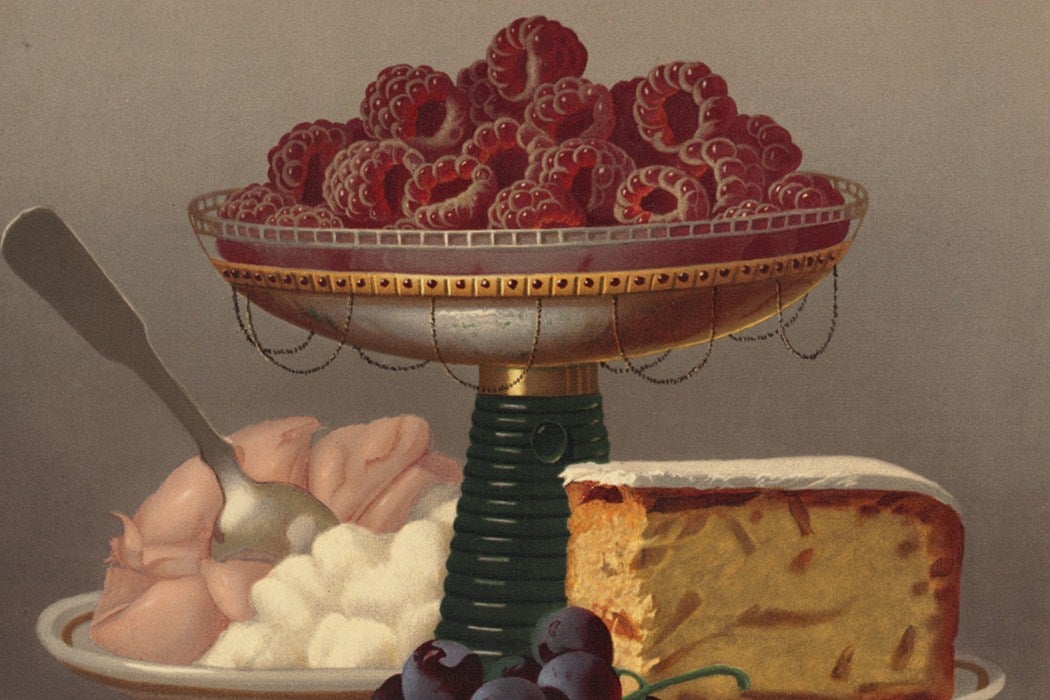Although he achieved almost unthinkable fame for the Victorian era, the life of chef Alexis Soyer is now considered a fairly obscure topic, infrequently discussed outside culinary circles. Soyer was born in 1810, in France, to a working-class family. His older brother, a Paris chef, helped secure an apprenticeship for Alexis with the highly regarded Georg Rignon, for whom he began working at the tender age of 11. When Soyer moved on, it was to Maison Douix, one of the most famous restaurants in Paris. After a year, he became chef de cuisine. He was 17.
Turmoil in France led Soyer to immigrate to England, where he once again accepted a position arranged by his brother, cooking for the Duke of Cambridge. (It was fashionable at the time for the wealthy to hire French chefs to cook in their homes.) Soyer moved from grand house to grand house, creating a name for himself and waiting for his big break.
It came. The Reform Club, the Whig Party’s answer to the Tory Carlton Club, needed a chef with a reputation, and, at 27, Soyer was just the man for the job. He became head chef at the club, where he worked for 13 years, creating a revolutionary, modernized kitchen complete with then-newfangled gas ranges. The kitchen was so widely celebrated and revered, the Club elected to open it for tours. Among Soyer’s devotees at the Club was the author William Makepeace Thackeray, who would sometimes skip social events in order to eat a particularly interesting Soyer-prepared meal.
It’s easy to see why. Soyer frequently cooked for royalty and dignitaries. Once, when the Pasha of Egypt came to London on a state visit, Soyer created something just for him. The restaurateur Prue Leith, in a lecture on the fine art of food, described it:
[A] detailed replica of the Step pyramid, the steps fashioned of pulled sugar. On the top of the pyramid was a portrait painted in food dyes on sugar paste, of the Pasha’s venerated father Ibrahim. As the Pasha picked it up to examine it more closely he saw that embedded in the filigree icing frame of the portrait was a tiny, but perfect, portrait of himself.
It’s difficult to imagine eating such carefully crafted extravagance.

Soyer also crafted a celebrity persona. He was known for his red beret, worn “à la zoug-zoug,” as he called it, cocked sideways on his head. He was eccentric, and he was meticulous about his clothing, going so far as to design his own waistcoats, cravats, and hats. It would not be an exaggeration to call him a dandy. His picture appeared in each of his books, and on the various sauces and relishes of his marketed by Crosse & Blackwell, a manufacturer of shelf-stable foods.
Although not everyone could eat at the exclusive Reform Club, Soyer’s cookbooks made him popular with all classes of people. According to Ruth Cowen, one of his biographers, Soyer was the first to publish a series of bestselling cookbooks. One of them sold a quarter of a million copies, unprecedented in the 19th century. Although he served in the sumptuous kitchens of the rich, his books were concerned with the everyday meals of an average home cook and were marketed accordingly.

Cowen’s biography also notes that Soyer was the first to sell merchandise based on his brand. Along with the sauces and relishes, he marketed a small, portable stove, the Magic Stove, intended for use while camping or picnicking. Over the years, he added more than two dozen gadgets—some for the professional chef, some for the average home cook—to his lineup.
Soyer’s strong business acumen and entrepreneurial spirit were tempered, however, by his healthy social conscience, especially as it related to food. During the Irish Potato Famine, in 1846, he petitioned the British government to let him set up several soup kitchens in the affected areas, where he fed thousands of people.
* * *
It is perhaps to be expected that Soyer had a temperamental nature. He threatened to resign from the Reform Club many times, and, in 1850, they finally accepted his resignation. Shortly after, preparations began for the first World’s Fair, the Great Exhibition of the Works of Industry of All Nations, held in London in 1851. Soyer took over a local estate and turned it into the Gastronomic Symposium of All Nations, which stood in direct competition to the food for sale within the Great Exhibition. Soyer’s establishment was a collection of 14 spaces themed for different regions, cultures, and experiences. There was an American bar, an Italian veranda, a room based on the Arctic, a room for China, and a grandly decorated bedroom. The gardens held a bar done up like an ice cave, complete with a dripping-icicle entrance. Soyer’s Gastronomic Symposium also offered activities and entertainment: dancing, fortune telling, even hot-air-balloon rides. Although it sounds extravagant, Soyer actually did everything in his power to make his grand production affordable for everyone, offering menus at several price points, seeking to accommodate all guests who might wish to enjoy the experience.
There were those who felt the restaurant was tacky and tasteless, a Las Vegas version of Paris long before such a thing existed. Still, it would have been a thrill to experience such varied dining experiences, especially in a culture where dining out was still quite new for the average person. And those who did visit were fortunate indeed: The restaurant closed only five months after it opened.
Still, Soyer’s conscience stayed with him. He became concerned about the way the military was handling troop meals and developed a stove specifically for the purpose of cooking while on the move, an invention that would help revolutionize the way the British military fed its soldiers. And when he learned about poor nutrition in military hospitals during the Crimean War, Soyer traveled to Scutari and began cooking for the patients there, working alongside Florence Nightingale. While in Crimea, however, Soyer contracted an illness from which he never fully recovered, even after he returned to England. He died in 1858 at the age of 48. “Soyer’s death is a great disaster,” Nightingale wrote. “Others have studied cookery for the purposes of gormandizing, some for show, but none but he for the purpose of cooking large quantities of food in the most nutritious and economical manner for great numbers of men. He has no successor.”
Has there been a more versatile chef, even with all of the benefits of modernity? Despite being well known, Soyer, like the celebrity chefs of today, was not always accorded much respect. He had the benefit of cooking for rarified audiences, and also of being a presence in most British homes in the form of a cookbook or two. He was one of the first to cook on a very large, very celebrated stage, paving the way for big-name chefs and novelty restaurants everywhere, and he didn’t shy away from cooking for those in need. His legacy provides a worthwhile template for modern celebrity chefs, a high bar of achievement and success.
In the copious advertising Soyer commissioned for his Gastronomic Symposium, everything was described in great detail, except one: the food. Like many celebrity chefs, and those who aspire to be them, Soyer wasn’t just selling sustenance. By attaching his name to the Reform Club, his restaurant, or a jar of relish, he was selling an experience, one that would be worth talking about, and squirreling away in memory, long after the food was consumed and forgotten.







